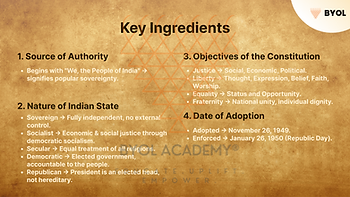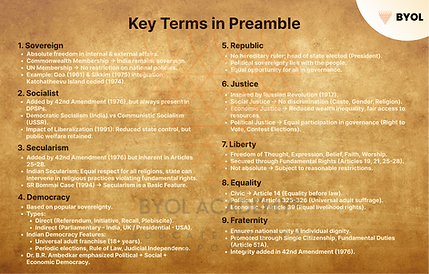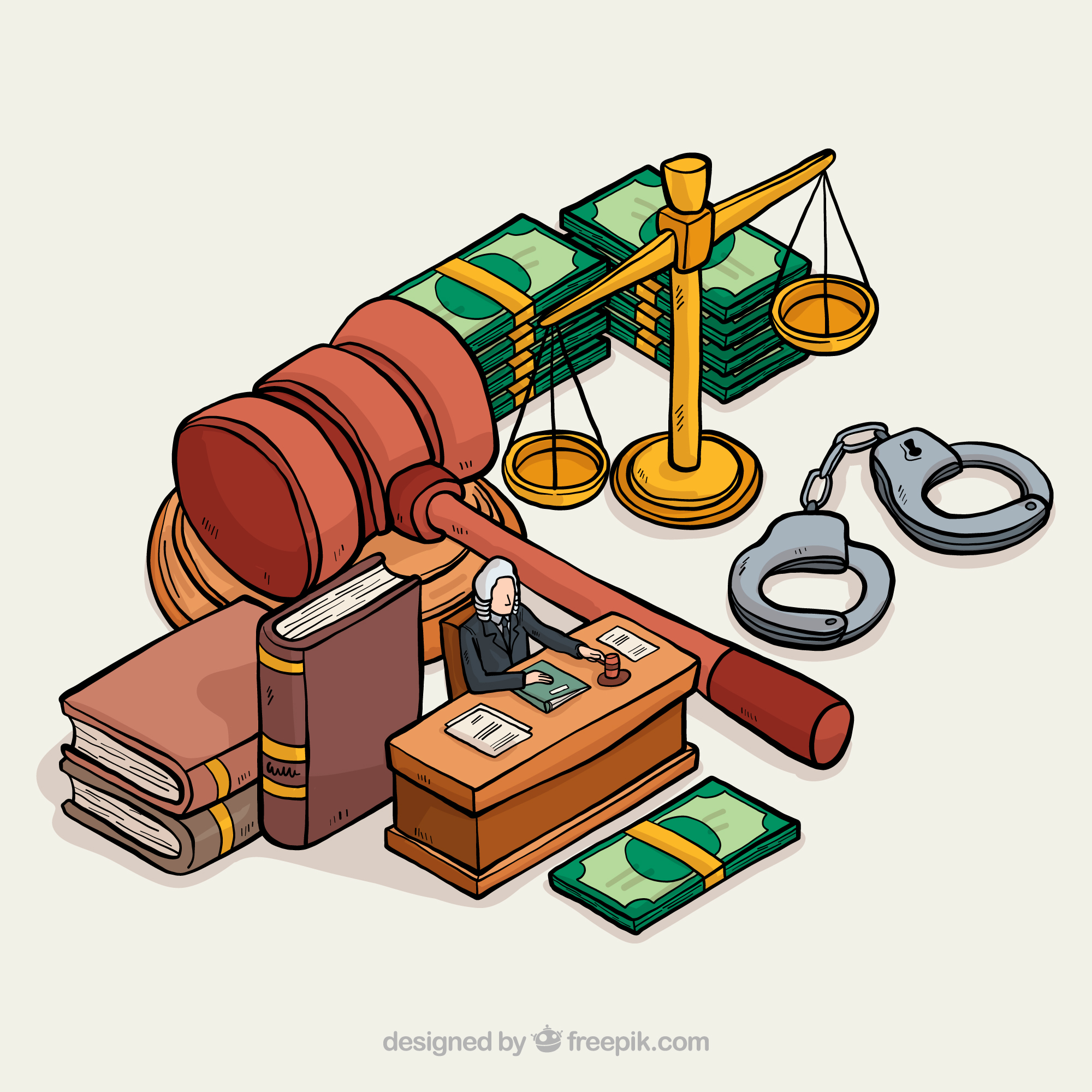Introduction
The Preamble serves as the introductory statement of the Indian Constitution, reflecting its ideals, philosophy, and objectives. It provides a brief summary of the fundamental principles that guide the governance of the country. The concept of a Preamble was first introduced in

the American Constitution, and several countries, including India, adopted this practice.
Eminent jurist N.A. Palkhivala referred to the Preamble as the “Identity Card of the Constitution,” highlighting its significance in defining the nature of the Indian state.
Origin of the Preamble
- The Preamble to the Indian Constitution is rooted in the Objectives Resolution, which was drafted and introduced by Pandit Jawaharlal Nehru in the Constituent Assembly.
- This resolution laid the foundation for India’s constitutional vision and was later adopted as the guiding principle of the Constitution.
- The 42nd Constitutional Amendment Act (1976) further refined the Preamble by adding three key words: Socialist, Secular, and Integrity, reinforcing India’s commitment to social justice, religious neutrality, and national unity.
Ingredients of the Preamble
1. Source of Authority of the Constitution
- The Preamble declares that the Constitution derives its authority from the people of India.
- It begins with “We, the People of India”, signifying popular sovereignty.
2. Nature of Indian State
The Preamble defines India as a:
- Sovereign – Independent in its internal and external affairs.
- Socialist – Ensures economic equality and social justice.
- Secular – No state religion; equal treatment of all religions.
- Democratic – Government elected by the people, accountable to them.
- Republican – Head of state (President) is elected, not hereditary.
3. Objectives of the Constitution

The Constitution aims to ensure:
- Justice – Social, Economic, and Political.
- Liberty – Of Thought, Expression, Belief, Faith, and Worship.
- Equality – Of Status and Opportunity.
- Fraternity – Promoting national unity and individual dignity.
4. Date of Adoption of the Constitution
- The Constitution was adopted on November 26, 1949.
- It came into effect on January 26, 1950 (Republic Day).
Key Words in the Preamble
Certain keywords–Sovereign, Socialist, Secular, Democratic, Republic, Justice, Liberty, Equality and Fraternity–are explained as follows;
1. Sovereign
- The term ‘Sovereign’ in the Preamble signifies that India is an independent state, free from the control of any external authority.
- India is neither a dependency nor a dominion of any other nation.
- It has full autonomy to conduct both internal and external affairs without interference.Commonwealth Membership & Sovereignty
- In 1949, India chose to continue as a member of the Commonwealth of Nations and accepted the British Crown as the symbolic head of the Commonwealth.
- However, this was an extra-constitutional declaration and did not limit India’s sovereignty in any way.
- India continues to exercise absolute control over its governance, laws, and international relations.
United Nations (UN) Membership & Sovereignty
- India’s membership in the United Nations Organisation (UNO) does not impose any restriction on its sovereignty.
- It participates in global decision-making but retains the power to make independent national policies.
Power to Acquire or Cede Territory
- As a sovereign state, India has the power to acquire foreign territories or cede its own territory to another nation.
- Example:
- Ceding of Katchatheevu Island to Sri Lanka (1974).
- Integration of Goa (1961) and Sikkim (1975) into India.
2. Socialist
- The term ‘Socialist’ was added to the Preamble by the 42nd Constitutional Amendment Act, 1976.
- However, India’s socialist philosophy was already embedded in the Constitution through the Directive Principles of State Policy (DPSP)
Socialism Before 1976
- Even before the 42nd Amendment, socialism was implicit in India’s governance model.
- The Congress party declared its goal of a ‘socialistic pattern of society’ at the Avadi Session in 1955.
Democratic Socialism vs. Communistic Socialism
- India follows Democratic Socialism, which differs from Communistic Socialism (State Socialism):
| Democratic Socialism (India) | Communistic Socialism (Soviet Model) |
| Allows private property but with state regulation. | Abolishes private property and nationalizes all industries. |
| Mixed economy: Both public and private sectors coexist. | State controls all means of production and distribution. |
| Focuses on economic equality & social justice without complete state control. | Implements strict central planning and government ownership. |
- The Supreme Court has upheld India’s commitment to democratic socialism, stating:
- “Democratic socialism aims to end poverty, ignorance, disease, and inequality of opportunity.”
Influence of Marxism and Gandhism
- Indian socialism is a unique blend of Marxism and Gandhism, though it leans more toward Gandhian socialism.
- Marxist Influence: Economic equality, elimination of class struggles.
- Gandhian Influence: Decentralized economy, self-sufficiency, village industries.
Impact of the New Economic Policy (1991)
- The introduction of Liberalization, Privatization, and Globalization (LPG) in 1991 diluted India’s socialist ideals.
- The economy shifted towards a market-driven approach, reducing state control over industries.
- Despite this, the state continues to regulate sectors like education, healthcare, and public welfare.
3. Secularism
Meaning and Origin
- The term ‘Secular’ was added to the Preamble by the 42nd Constitutional Amendment Act, 1976.
- However, even before this amendment, the idea of secularism was deeply embedded in the Indian Constitution through Articles 25 to 28, ensuring freedom of religion.
- The Supreme Court (1974) clarified that despite the absence of the explicit term ‘secular state’ in the original Constitution, the framers aimed to establish a secular polity.
Indian Concept of Secularism
- Unlike Western secularism, which promotes complete separation of state and religion, the Indian model follows a positive concept of secularism, meaning:
- The state treats all religions with equal respect.
- It neither promotes nor discriminates against any religion.
- The state can intervene in religious practices if they violate fundamental rights (e.g., abolition of untouchability, Triple Talaq judgment, etc.).
Articles Ensuring Secularism
- Article 25 – Freedom of conscience and free profession, practice, and propagation of religion.
- Article 26 – Freedom to manage religious affairs.
- Article 27 – Freedom from taxation for the promotion of a particular religion.
- Article 28 – Freedom from religious instruction in state-funded institutions.
Supreme Court’s View on Secularism
- In the SR Bommai Case (1994), the Supreme Court ruled that secularism is a basic feature of the Constitution, and any state government acting against it can be dismissed under Article 356.
- In 1997, the SC reaffirmed that the Constitution envisions an egalitarian society, ensuring social, economic, and political justice through secularism and democracy.
4. Democracy
Meaning and Types of Democracy
- The Preamble of the Constitution proclaims India as a democratic republic based on the principle of popular sovereignty (i.e., supreme power rests with the people).
- Democracy can be of two types:
- Direct Democracy: Citizens exercise power directly (e.g., Switzerland).
- Devices of Direct Democracy:
- Referendum – People directly vote on a proposed law.
- Initiative – Citizens propose legislation.
- Recall – Voters can remove an elected official before the end of their term.
- Plebiscite – A vote by the electorate on a specific political question.
- Devices of Direct Democracy:
- Indirect Democracy (Representative Democracy): People elect representatives to govern on their behalf. It is of two types:
- Parliamentary Democracy (India, UK) – Executive is responsible to the legislature.
- Presidential Democracy (USA) – Executive is independent of the legislature.
- Direct Democracy: Citizens exercise power directly (e.g., Switzerland).
Parliamentary Democracy in India
- The Indian Constitution provides for a parliamentary system, where:
- The President is the constitutional head, while the Prime Minister and Council of Ministers wield real power.
- The executive is accountable to the legislature.
Features of Indian Democracy
- Universal Adult Franchise – Every citizen above 18 years has the right to vote (Article 326).
- Periodic Elections – Free and fair elections conducted by the Election Commission.
- Rule of Law – No one is above the law (Article 14).
- Judicial Independence – The judiciary acts as the guardian of the Constitution and protector of fundamental rights.
- Social and Economic Justice – Envisioned through Directive Principles of State Policy (DPSPs) and welfare schemes.
- No Discrimination – Article 15 prohibits discrimination based on religion, caste, sex, race, or place of birth.
Social and Economic Democracy
- Dr. B.R. Ambedkar, in his concluding speech to the Constituent Assembly (November 25, 1949), emphasized that:
- Political democracy alone is insufficient unless it is backed by social and economic democracy.
- Democracy must ensure liberty, equality, and fraternity in a holistic manner.
“Liberty cannot be divorced from equality, equality cannot be divorced from liberty. Nor can liberty and equality be divorced from fraternity.” – Dr. B.R. Ambedkar
- Without equality, liberty leads to the dominance of a privileged few.
- Without liberty, equality suppresses individual initiative.
- Without fraternity, democracy lacks unity and social cohesion.
Supreme Court’s Observations (1997)
- The Constitution aims to establish an egalitarian social order.
- Democracy in India is not just about political representation but also about ensuring social, economic, and political justice for all citizens.
5. Republic
Meaning and Classification of a Democratic Polity
- A democratic polity can be categorized into two types:
- Monarchy – The head of the state (King/Queen) holds a hereditary position (e.g., Britain, Saudi Arabia).
- Republic – The head of the state is elected either directly or indirectly for a fixed tenure (e.g., USA, India).
Republican Nature of India
- India is a republic, as declared in the Preamble. This means:
- Elected Head of State – The President of India is elected indirectly by an Electoral College for a term of five years (Article 54).
- Political Sovereignty lies with the People – Power is not vested in a single ruler but in the people, who elect representatives through universal adult franchise.
- Absence of Privileged Class –
- No individual or group enjoys special hereditary privileges in governance.
- All public offices are open to every citizen based on merit and qualifications.
Significance of a Republic
- A republic ensures equal opportunity for all citizens in governance and decision-making.
- It promotes democratic values, accountability, and transparency.
- Unlike a monarchy, where power is inherited, a republic upholds the principle of meritocracy and electoral legitimacy.
6. Justice
Meaning and Dimensions of Justice
The Preamble of the Indian Constitution enshrines the ideal of justice in three interrelated forms:
- Social Justice
- Economic Justice
- Political Justice
These principles are secured through Fundamental Rights (Part III) and Directive Principles of State Policy (Part IV).
Origin of the Concept of Justice
- The ideal of justice (Social, Economic, and Political) in the Preamble is inspired by the Russian Revolution of 1917, which emphasized economic equality and social justice.
1. Social Justice
- Ensures equal treatment of all citizenswithout discrimination based on:
- Caste, colour, race, religion, gender, or social status.
- Aims to remove historical injustices against marginalized communities (SCs, STs, OBCs, and women).
- Promotes affirmative action (e.g., reservation policies, special welfare programs).
- Eliminates social privileges and untouchability (Article 17).
- Ensures dignity of individuals and communities.
2. Economic Justice
- Aims to reduce economic inequalities in wealth, income, and property.
- Prohibits discrimination based on economic background.
- Ensures access to basic necessities such as food, shelter, healthcare, and education.
- DPSPs promote redistributive policies (e.g., land reforms, minimum wages, poverty alleviation programs).
- Prevents monopolies and exploitation by regulating corporate dominance.
- Combined with social justice, it results in distributive justice, ensuring fair access to opportunities and resources.
3. Political Justice
- Ensures equal political rights for all citizens.
- Guarantees:
- Right to Vote (Universal Adult Franchise, Article 326).
- Equal access to political offices (No discrimination in contesting elections).
- Equal participation in governance (Rule of Law & democratic principles).
- Prevents political suppression and ensures free, fair, and periodic elections.
Historical Influence
The ideals of Liberty, Equality, and Fraternity were borrowed from the French Revolution (1789-1799).
7. Liberty

Meaning of Liberty
- Liberty means freedom from arbitrary restrictions while ensuring opportunities for personal development.
- It includes freedom of thought, expression, belief, faith, and worship as enshrined in the Preamble.
Constitutional Safeguards for Liberty
- Liberty is ensured through Fundamental Rights (Part III), which are legally enforceable in courts.
- Key Fundamental Rights that uphold liberty:
- Article 19 – Freedom of speech, expression, movement, association, and profession.
- Article 21 – Right to life and personal liberty.
- Article 25-28 – Freedom of religion (belief, faith, and worship).
Liberty is Not Absolute
- Liberty does not mean an unrestricted license to do anything. It is subject to reasonable restrictions imposed by the state in the interest of public order, morality, and national security.
- Example: The right to free speech (Article 19) does not allow hate speech, defamation, or inciting violence.
8. Equality
Meaning of Equality
- Equality means the absence of special privileges and equal opportunities for all without discrimination.
- The Preamble guarantees equality of status and opportunity.
Dimensions of Equality
The Indian Constitution promotes three types of equality:
- Civic Equality – Equal treatment of all before the law.
- Political Equality – Equal political rights for all citizens.
- Economic Equality – Equal access to economic opportunities and resources.
Constitutional Provisions Ensuring Civic Equality
Fundamental Rights provide strong protections against discrimination:
- Article 14 – Equality before the law and equal protection of laws.
- Article 15 – Prohibition of discrimination on grounds of religion, race, caste, sex, or place of birth.
- Article 16 – Equal opportunity in matters of public employment.
- Article 17 – Abolition of untouchability.
- Article 18 – Abolition of titles (to promote egalitarianism).
Political Equality
- Article 325 – No citizen shall be denied inclusion in electoral rolls on grounds of religion, race, caste, or sex.
- Article 326 – Elections to Lok Sabha and State Assemblies are based on universal adult suffrage (one person, one vote).
Economic Equality
- Article 39 (DPSP) – Ensures equal right to livelihood and equal pay for equal work for both men and women.
9. Fraternity
Meaning of Fraternity
- Fraternity refers to a sense of brotherhood, unity, and national integration.
- It aims to ensure the dignity of individuals and the unity and integrity of the nation.
Mechanisms Promoting Fraternity
- Single Citizenship – All Indians share one national identity regardless of state or region.
- Fundamental Duties (Article 51A) –
- Promote harmony and common brotherhood among all Indians, transcending religious, linguistic, regional, or sectional diversities.
- Protect the dignity of women by renouncing practices derogatory to them.
- Uphold and protect the sovereignty, unity, and integrity of India.
Ensuring Dignity of Individuals
- The Constitution ensures that every individual is treated with respect and fairness, through:
- Fundamental Rights (protecting civil liberties).
- Directive Principles (ensuring social and economic justice).
- Fundamental Duties (encouraging respect for human values).
Ensuring National Unity and Integrity
- The word “integrity” was added to the Preamble by the 42nd Constitutional Amendment Act, 1976.
- Article 1 describes India as a “Union of States”, ensuring that no state has the right to secede from the Union.
- National integration efforts combat threats like communalism, casteism, regionalism, and separatism.
- Liberty, Equality, and Fraternity form the bedrock of India’s democratic system.
- Liberty ensures freedom within constitutional limits.
- Equality promotes non-discrimination and equal opportunities.
- Fraternity fosters national unity, social harmony, and dignity for all individuals.
- These principles, drawn from the French Revolution, are crucial in maintaining a just, inclusive, and progressive society.
Amendability of the Preamble
1. Controversy Over the Status of the Preamble
- Debate exists on whether the Preamble is a part of the Constitution or merely a guiding introduction.
- The Supreme Court has given varying interpretations over time.
2. Supreme Court’s Views on the Preamble
(i) Berubari Union Case (1960)
- Preamble is NOT a part of the Constitution.
- Serves as a key to understanding the minds of the Constitution-makers.
- Helps in interpreting ambiguous terms but has no independent legal force.
(ii) Kesavananda Bharati Case (1973)
- Preamble IS a part of the Constitution.
- Should be read in the light of the “grand and noble vision” of the Constitution.
- Laid down the Basic Structure Doctrine, reinforcing the Preamble’s importance.
(iii) LIC of India Case (1995)
- Reaffirmed Kesavananda Bharati’s ruling.
- Declared the Preamble an integral part of the Constitution.
3. Constituent Assembly’s Stance
- The Preamble was adopted after the rest of the Constitution was finalized, ensuring alignment with all provisions.
- While presenting the Preamble for adoption, the President of the Constituent Assembly explicitly put it to vote, confirming its constitutional legitimacy.
4. Limitations of the Preamble

- Not a source of legislative power: It does not grant authority to make laws.
- Not a prohibition on legislative power: It does not impose restrictions on Parliament’s powers.
- Non-justiciable: Courts cannot enforce the Preamble’s ideals directly.




